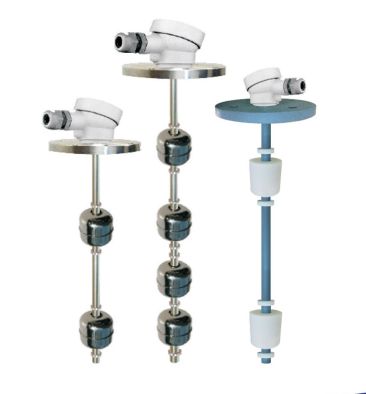Different types of magnetic level switch sensors and how they work

Continuous level sensors with a magnetic float that rises and falls in response to changes in liquid levels are known as floating level sensors. The level sensor’s stem contains a hermetically sealed reed switch that is activated by the movement of the float, producing a magnetic field that causes the switch to open or close.
For commercial and industrial applications involving water, oil, chemicals, and other liquid components, many float switch versions are employed. There are choices for side mount and vertical installation, and you may choose between a stem made of stainless steel or hard plastic.
Hanla IMS produces a wide range of float switches, including bulk material switches, suction pipe sensors, tiny float switches, and programmable level sensors. All of their products have sturdy housing designs and come in a variety of configurations to fit your specific requirements.
Learn more about their Magnetic level switch sensor products below, or get in touch with them for help deciding which one is best for your application and working conditions.
In a variety of operational situations, float-level switches and sensors give accurate readings:
Sensors for suction pipes:
In car washes, washing machines, dishwashers, and other industrial applications, suction pipe level sensors are generally used to dosage liquids and stop pumps from running out of fuel. The PVC and PP suction pipe sensors contain up to two switch points, are depth-adjustable, and come in a variety of home connections.
Level sensors and switches with programmability:
Push-button programming on programmable level sensors enables users to set the sensor up for various switching points, level settings, and minimum/maximum settings. The level sensor is suitable with almost any type of material since it is constructed from stainless steel tubing in lengths up to 2000mm. There are also spinning heads and plastic pipes available.
Float level switches that are small:
Small float switches can withstand a variety of fluids, temperatures, and pressures and are intended for single-point tank monitoring. Reed switch technology, a non-magnetic float, and internal or exterior threaded installation are features. offered in several versions with on-demand customization.
Level sensors with a side mount:
The inside or outside of a tank can be used to put side mount level sensors, which are made for single-point tank monitoring. They are operated using a non-magnetic float and reed switch technology and can be hinged or attached using a Teflon® flap. In order to satisfy your needs, we provide a variety of models and styles.
Switches for Bulk Material Level:
Solid bulk materials with conical shapes are measured using bulk material switches, which mount to the side of a bin. These float switches provide a choice of N.C. or N.O. contact forms and use magnetic reed technology.
Benefits of a level switch for fuel tank management:
Fuel is a resource. To run a prosperous business, it is essential to safeguard this asset and use it appropriately. This is where a gasoline tank monitoring system can pay off, as it works to do more than simply measure the amount of fuel still in storage tanks; it also works to save money and boost efficiency in a variety of ways.
Owners and operators can keep track of everything from fuel levels to temperature, pressure, and other important characteristics thanks to sensors and other data-tracking components included in the fuel framework.
The significance of fuel tank monitoring and some of its main benefits are discussed in more detail below:
The best fuel tank monitoring systems have these features:
Fuel is a resource, and by safeguarding it, you may make the most of it while still running your daily operations. Monitoring fuel tanks are essential for maintaining compliance with environmental laws.
- Boost operational effectiveness through quick action:
Systems for monitoring gasoline tanks may control every element of fuel, including its purchase, use, quality, and final sale.
In essence, fuel tank monitoring systems enable owners and operators to boost operational effectiveness through real-time monitoring of key variables crucial to critical choices. Owners and operators may even remotely monitor and make adjustments thanks to remote sensors.
If a problem is found, you are notified right away so that changes or repairs may start sooner and be based on current events rather than data from days or weeks earlier. In addition to safeguarding your investment, this also cuts down on lost fuel and downtime.
- Environmental conformity:
Tanks for fuel need regular repair. As they get older, elements like rust and algae development can have an effect on the environment as well as the fuel’s quality. In the case that a gasoline tank is destroyed, fuel might leak and perhaps contaminate nearby soil and/or groundwater.
One of the major benefits of a gasoline tank monitoring system is the speed at which problems are found, enabling quicker repairs and reducing the impact on the environment.
A fully integrated system, the milk filling system:
The advanced milk tanker security system is built on a wireless computerized system that safeguards milk from cow to customer. Automation, often known as automated control, is the use of various control systems to operate machinery, factory processes, and other applications with little or no human involvement. Certain procedures have been fully automated.
The primary advantage of automation is that it increases quality, accuracy, and precision while saving money on labor, energy, and materials. The dairy business is now expanding quickly.
A rapidly developing and increasing technologically based cost-effective solution for the dairy industries are called dairy automation. It is a fantastic fusion of several top-notch technologies.
The transportation of milk from dairy farms to customers in the retail market is one of the challenges that the dairy sector faces. In large farms, milk is delivered to the milk processors first. The bulk milk transportation industry requires a security upgrade that will allow routine milk transport operations to continue while also preventing illegal access to milk in transit or storage and minimizing recording mistakes.
The Milk Transport Security System is a fully integrated system that will increase operational effectiveness and provide the dairy sector with safety and defense measures. Based on feedback from producer organizations, processors, and transportation firms, the Advance Milk Tanker Security System was created. It consists of a data server, a portable handheld computer, and a computer processor mounted on the tanker that controls the Security Monitoring System.
The information on dairy producers, dairy processors, and milk transportation companies is monitored, tracked, and stored by the Milk Transport Security System. Relevant information includes tanker capacity, Interstate Milk Shippers or state identity numbers, and location-specific GPS coordinates. The software solution will let authorized users update the server-stored data.
The portable handheld computer is intended to be a shock- and water-resistant, as well as protected against drops. It is used to enter information that is generally centered on handwritten papers like the milk ticket or tanker wash tag by the milk hauler/sampler or other authorized users.
The mobile gadget may offer the most recent information on things like logistics and pick-up schedules. The system makes use of a portable computer that gets information on the weight, temperature, and pick-up time of the milk, among other things.
The mobile device then transmits the data to a data server and makes it accessible over the Internet. Those worried about milk security may quickly access information on bulk milk collection and transit that has been gathered, saved in a database, and made public.




